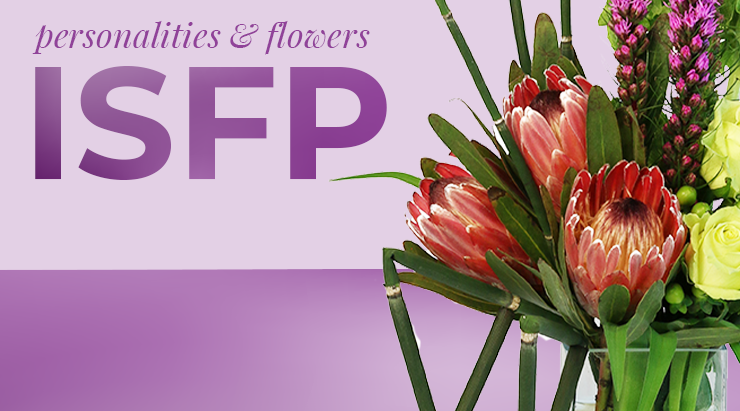
The Adventurer is a true artist, using aesthetics, design, and even choices and actions to push the limits of social convention. Looking for the perfect flowers to send an ISFP? We know just the ones! [Read more…]
Everything you want to know about flowers!

The Adventurer is a true artist, using aesthetics, design, and even choices and actions to push the limits of social convention. Looking for the perfect flowers to send an ISFP? We know just the ones! [Read more…]
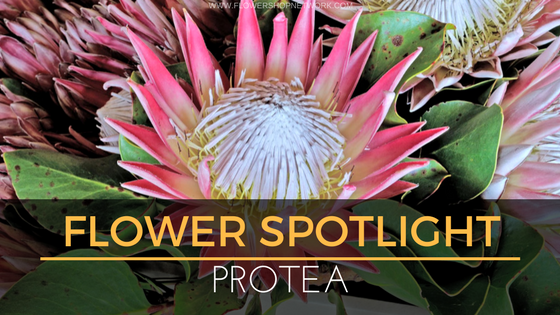
Not many flowers are lucky enough to survive the changing times of our planet. Proteas are not only ancient but beautiful and truly one of a kind. Want to learn more about this exotic beauty? Keep on reading!
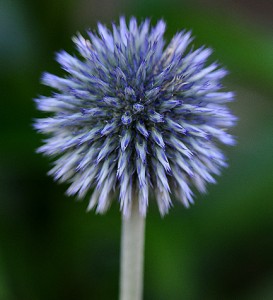 Globe Thistle |
Globe Thistle (Echinops ritro)
Globe Thistle is a clump-forming herbaceous perennial with coarse, prickly leaves with 1-2 ball-shaped silvery-lavender-blue or dark blue flowerheads blooming in early to late summer on rigid branching stems 24-48 inches tall. These beautiful ornamentals grow best in full sun to mostly sunny areas and attract bees and butterflies. In the garden, they will tolerate heat and are deer-resistant. They make excellent cut flowers as well as great additions to dried bouquets.
This flower IS available from your local florist*.
 Allium Bulgaricum |
Allium Bulgaricum (Nectaroscordum siculum)
This ornamental allium is easy to grow, deer-resistant, and hardy to zone 4. They thrive in sunlight and bloom in May and June. Also known as Mediterranean Bells, Sicilian Honey Lily, Ornamental Onion and Sicilian Garlic, they are native to the Mediterranean. The individual florettes begin in an upright position and gradually relax to a cluster of tricolored bells and begin to drape like a floral chandelier. They make an interesting addition to flower arrangements.
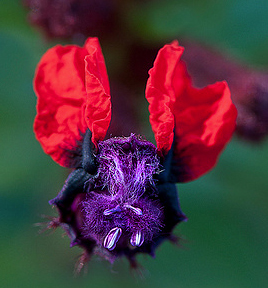 Bat Face Cuphea |
Bat Face Cuphea (Cuphea llavea)
Also known as St. Peter’s plant, Tiny Mice and Bunny Ears, Bat Face Cuphea is a tender tropical evergreen perennial native to Mexico. Bat Face Cuphea prefer partial to full sun and its distinctive red and purple flowers blooms from March through October. Attractive to hummingbirds and bees, the plant is low maintenance, drought-tolerant and makes a great plant for pots, planters, and beds. The plants will grow 2-3 feet tall by 3 feet wide. In early summer, pinch growth off to encourage branching.
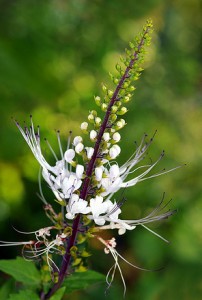 Cat’s Whiskers |
Cat’s Whiskers (Orthosiphon stamineus)
Part of the mint family, Cat’s Whiskers are herbaceous perennial flowering plants originating in tropical East Asia. They grow up to two feel tall and three to four feet wide. The flowers have an orchid-like appearance and are white or lavender, sprouting long stamens that resemble cat’s whiskers. They attract butterflies and hummingbirds and can be harvested to use in herbal teas.
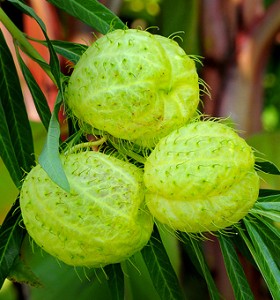 Family Jewels Milkweed |
Family Jewels Milkweed Tree (Asclepias physocarpa)
This species of milkweed is also known as White Butterfly Weed or Swan Plant. Native to Jamaica and South America, this perennial herb can grow to over six feet and prefers full sun and well-drained soil. It is a food source for caterpillars and is a food and habitat plant for the Monarch Butterfly. The small flowers are creamy white and orchid-like, followed by translucent, inflated 2″ green balls covered with soft bristles that are the resulting seedpods. It is a fast-growing tender perennial and grows best in Zones 7-10.
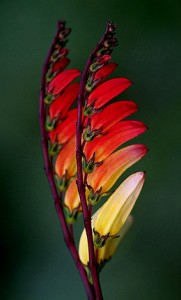 Spanish Flag |
Firecracker Vine or Spanish Flag (Mina lobata)
A tender perennial grown as an annual, this fast climber can grow 10 to 20 feet tall. The incredibly intense-colored 1.5″ blooms are reddish-orange fading to orange yellow and white flowers from mid-summer to fall. Two cultivars include Citronella (cream flowers and red buds) and Mexican Fiesta (red and yellow flowers). A member of the morning glory family, Spanish Flag can be grown in sun to partial shade and is best grown on a lattice.
 Hot Poker |
Red or Yellow Hot Poker (Kniphofia)
Red Hot Poker (Kniphofia uvaria) and Yellow Hot Poker plants are grown from bulbs, and are heat and drought tolerant. They can grow 36″ tall. This variety is ‘Sally’s Comet’ Yellow Hot Poker. Native to Africa, they are known as Torch Lilies. Upright, rocket-shaped blooms produce ample nectar during blooming and are hummingbird magnets. They must be grown in full sun and require good drainage to prevent crown rot. They may spread up to three feet wide. Hardy to zones 5-10.
This flower IS available from your local florist*.
 Liatris |
Liatris or Blazing Star (Liatris)
Hardy perennials White Liatris (Liatris spicata ‘Alba’) and Purple Blazing Star Liatris (Liatris spicata purple), are also known as Gayfeather and Button Snakeroot, and are a member of the Aster family. They bloom from the top down, which is unusual with flowering plants. Each spike is comprised of tiny flowers that are a magnet for pollinators. Ranging from 2-4′ tall, they add height to flower beds and are a popular cut flower in summer floral arrangements with a long vase life.
This flower IS available from your local florist*.
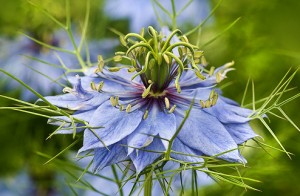 Love-in-a-Mist |
Love-in-a-Mist (Nigella damascena)
Love-in-a-Mist is a beautiful Victorian garden annual blooming in soft shades of blue, pink, white, and lavender. Because its fern-like leaves look similar to fennel, it has also been called fennel flower. This annual herbaceous plant is in the buttercup family (Ranunculaceae), readily self-seeds, and is common in old-fashioned cottage gardens. It grows in full sun to partial shade and blooms from late spring through fall. Nigella is short-lived, so for continuous bloom, repeat sowing every four weeks. You can cut and deadhead this plant to keep it flowering longer.
This flower IS available from your local florist*.
Ask The Expert: What is the name of a pink, cactus-like flower? This flower is used by florists. One of the places this flower is grown is high up on Maui in a greenhouse. It keeps it’s shape when dried. Also keeps its shape for lone periods of time when fresh in arrangements. -Malia
Flower Shop Network‘s Plant Expert Reply: I have attached a picture of what I think the plant is. Does this look like the plant in question? If so it is a Protea.
From Malia: That is exactly what it is!! Thank you so much. It was driving us crazy.
The protea looks amazing in fresh floral arrangements. However, as Malia mentioned, the protea keeps it’s shape when dried — this is true! The protea is a fantastic flower, both fresh and dried.
Don’t forget to send us pictures of your beautiful, dried protea. We can’t wait to see how it turns out!
This post is brought to you by local, Kailua HI florists.
No where near Kailua? Use Flower Shop Network’s handy directory of real, local florists to find a florist near you!
Many brides and grooms are looking for the unusual and the exotic in flowers for their wedding. They desire something that strikes their wedding guests as exceptional. Tropical flowers bring the WOW to weddings. As I think back on all the weddings I’ve attended over the years, it is only the Hawaiian themed wedding that I remember vividly. In fact, the red ginger flowers made a huge impression on me. So much that I thought to myself, “Why did I go with the beautiful red roses for my wedding instead of these gorgeous tropical flowers.” I could kick myself for not going bold and exotic. After all, the tropical flowers at this particular wedding were outstanding.
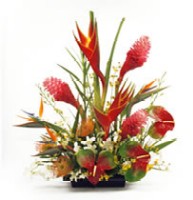
We often think that tropical flowers are difficult to obtain or maybe not traditional enough for a customary wedding, but tropical flowers can and do work with other conventional flowers. A rose of any color mixed with coordinating cattleya orchids, makes a traditional bridal rose bouquet extraordinary. No one should be afraid to experiment with traditionally known wedding flowers such as carnations, roses, gerberas and babies breath mixed with Bird of Paradise or anthuriums. Even the foliage of tropical plants mixes well with traditional flowers. Think of the exquisite tropical centerpiece arrangements that can adorn your wedding reception tables.
Summer weddings especially lend themselves to the tropical flower theme. With the vibrant strong colors that almost all tropical flowers possess, they won’t hide in the corner. Passion and beauty is what they will announce as a key component of summer wedding bouquets. Tropical Flowers easily transition into wonderful fall wedding flowers options. Orchids especially work wonderfully with other fall flowers to add a little exotic flare.
The best aspect of tropical flowers is the unusual shape. The Bird of Paradise with its unusual flower works well for a groom’s and groomsmen’s boutonnières. If you find the standard Bird of Paradise to be too large you can get a mini (dwarf) Bird of Paradise. Unconventional use? Certainly but it works well. For the guys who don’t want to wear a flower, this is the answer.
Pineapples, bromeliads and protea are excellent candidates for reception table centerpieces. For example, position a few proteas at the base of the pineapple stem as it lay on a bed of tropical foliage. Create an unusual wedding centerpiece with clean and crisp lines. Although this tropical flower arrangement is very simplistic in design, it will have a strong visual impact without obstructing any viewpoints. Any combination of these tropical flowers is a wonderful and unique way to really bring the tropical feel to your wedding receptions. While bromeliads are often used as a potted plant they can easily be incorporated into your wedding decorations. The colorful bloom and striking foliage produce an amazing visual display. Florists can design floral arrangements that incorporate the potted bromeliad. Potted bromeliads can be neatly decorated on wedding reception tables and later given as wedding favors.

Choose a lei instead of traditional flowers for the bridesmaids, or even go all the way and give your guest small leis called kupe’e that are to be worn on the wrist or around the ankle if at an informal wedding. The kupe’e can be your wedding gift favors. Traditionally lei’s are made from orchids, but you can use roses, ginger, maile, or any other flowers or a mixture of flowers you can string together.
The use of anthuriums “Haitian pink” in a wedding bouquet makes a stunning non-traditional but elegant brides bouquet. The anthuriums’ heart shaped flowers, and the beautiful light pink color will coordinate with any color wedding dress the bride wears or even the bridesmaids’ dresses. If you dislike pink choose any of the other anthuriums. They come in red, white or even a tropical color that lightly fades from pink in the middle to green on the outer most of the flower. Any choice of a tropical flower or a concept of an arrangements or bouquets can be done, it’s all in the creative way florist do their work.
One thing we know about tropical flowers is that they are unusual, exotic and used infrequently. We all tend to opt for traditional. Tried-and-true works well, but we have to admit that it is easy. It’s time we all think out side the tried-and-true box and go with the exotic, the remarkable, the extraordinary, tropical flower arrangements. Just as I was mesmerized by the red ginger at the wedding, tropical flowers captivate us because they are new to us. Though I didn’t know what they were at the time, I took the time to find out because they caught my eye. Putting a tropical flower arrangement of anthuriums, orchids, and Birds of Paradise will not only look grand, but will certainly make for great conversation pieces at any party. Guests will be curious as to the type of flower or that and who did the arrangements. That is the WOW factor of tropical plants.
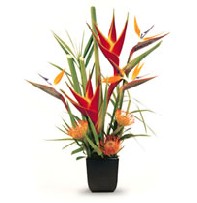
Choosing a tropical arrangement of orchids mixed with other exotic flowers and giving them just because will be well received and talked about for months on end. Maybe you want a plant and not just a flower arrangement. In that case, tropical plants are another wonderful gift to send. A gloriosa lily, a striking plant that has a flower that has gold based flowers with crimson tipped ends, is an absolute tropical beauty. The gloriosa plant is best suited to mild climates for outdoor planting or it can be gown inside as a potted plant.
The use of tropical flowers for a party, wedding or flower arrangement will bring a WOW factor to any occasion and will brighten up any décor. Everyone should explore the world of tropical flowers and plants. Why not celebrate their uniqueness and exotic looks? Not ready to move completely out of the tried-and-true box? Well spice up a traditional styled arrangement with tropicals. Come on. You know that you want to. Just a few here and there and you’ll be exploring the ever-growing world of tropical flower arrangements.
Contributor Leigh Morrisett
Photos Provided by Aloha Flower Leis – One of Flower Shop Network’s Honolulu Florists.
Need to send a tropical flower arrangement to someone? Check out the following: Tropical Getaway flower basket arrangement Tropical Flair. Tropical Tribute

I attended a birthday party last night for a Parrot Head (a Jimmy Buffet Fan) and as you can imagine the decorations and drinks screamed “tropical”. The most impressive thing at the party was the margarita table and not because of the margaritas. The hostess had her local florist create a beautiful tropical flower arrangement for the table. The arrangement was similar to this one
 but on a larger scale. This arrangement contains bird of paradise, anthurium, protea, horsetail, hypericum, curly willow & monstera.
but on a larger scale. This arrangement contains bird of paradise, anthurium, protea, horsetail, hypericum, curly willow & monstera.
The arrangement at the party also included ginger. The tropical theme was continued through out the party. Vases containing bird of paradise, ginger, protea and anthurium were also on the food table. It was nice to see someone using tropical flowers as a table decoration. We all tend to neglect using exotic or tropical flowers in favor of more traditional flowers. I love to Protea in a ginger jar. I would love to know how you use use tropical flowers?
Copyright © 2025 · News Theme on Genesis Framework · WordPress · Log in


 Find Your
Find Your